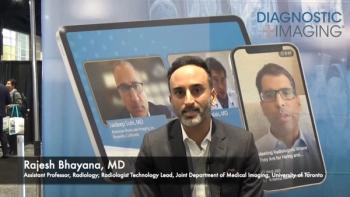
GE trimmed in time for tight market
Health-care cost containment has dampened demand for expensive,high-end imaging equipment and forced multimodality vendors tocut costs and refocus product strategies. Slackening demand forbig-ticket scanners cut annual revenue growth at industry leaderGE
Health-care cost containment has dampened demand for expensive,high-end imaging equipment and forced multimodality vendors tocut costs and refocus product strategies. Slackening demand forbig-ticket scanners cut annual revenue growth at industry leaderGE Medical Systems from double-digit rates in the 1980s to singledigits, according to GEMS senior vice president and group executiveJohn Trani. Trani was interviewed for an article published inthe Milwaukee Journal last month.
"With that new, different environment, our industry growthrate is perhaps half . . . what it was in the past few years,"he told the Journal.
The changing medical imaging business climate was also highlightedby Trani's boss, GE CEO Jack Welch, in a recently published book.Control Your Destiny or Someone Else Will was written jointlyby Noel M. Tichy, a consultant to GE, and Stratford Sherman, senioreditor at Fortune magazine, according to an article last monthin the Houston Chronicle.
"The medical diagnostic imaging business is a perfectexample of what's happening everywhere," Welch told the authors."The market is shifting away from the technology leader inthe high-end niche to the guy with the basic, proven, low-pricedsystems that produce acceptable images. Governments have decidedthey don't want to pay more for health care, so if you're tryingto pitch some new hot technology the customer's going to say,`See you later.'"
GE and other vendors have met demand for price reductions bytrimming staff and bringing features originally developed forhigh-ticket scanners down to lower priced technology in CT, MRIand other imaging modalities.
GEMS's approximately $3.5 billion annual revenue and continueddouble-digit profit growth pay tribute to Trani's foresight sixyears ago when he was transferred to GE's medical business andbegan delayering and consolidating operations (SCAN 2/3/88, 9/27/89and 10/25/89). One of Trani's first moves at GEMS was to consolidateGE's separate ultrasound operations in Rancho Cordova, CA, intoMilwaukee headquarters.
GE Medical Systems currently employs about 15,000 people worldwide,according to the Milwaukee Journal article. This number will bereduced further, largely through attrition and decreasing temporaryemployment. Reductions are targeted in manufacturing, althoughsome employees will be transferred to other functions.
Competitor Siemens, on the other hand, has a 30,000+ work forceworldwide. The German vendor plans to trim about 1800 medicalpositions this year, half of which will come from its home market(SCAN 10/7/92). Comparing the two medical businesses should bedone cautiously, though, since Siemens incorporates more nonimagingbusinesses, such as that of cardiac pacemakers, than GE.
GE's product strategy over the past five years has leaned todevelopment of lower priced equipment. GE started out in MRI,for instance, as exclusively a high-field advocate but later introducedits own, less expensive mid-field MR Max system. Eventually, featuresdeveloped on GE's 1.5-tesla Signa system were introduced on the0.5-tesla Signa and a second mid-field MRI system, Vectra, wasintroduced (SCAN 6/3/92).
Most recently, GE's Japanese subsidiary Yokogawa Medical Systemshas introduced a low-priced, high-field MRI system for that extremelycost-competitive market (see story, page 4).
Medical imaging revenue has also been maintained at GEMS throughdevelopment of international markets, particularly in Europe andAsia. While sales growth is also slowing internationally, opportunitiesfor growth still exist in new markets like Southeast Asia andLatin America, Trani told the Journal. Over 40% of GE's medicalsales are generated outside the U.S.
GE's worldwide medical imaging sales were approximately $1.5billion in 1986, prior to its acquisition of France's Thomson-CGR,according to statistics provided by GE-CGR six years ago. At thetime, Siemens' world medical revenues, at $1.9 billion, exceededGE's. Thomson-CGR had $700 million in revenue during 1986.
Combining with CGR propelled GE to the top of the heap in worldwidemedical imaging revenues and opened up new prospects for growth.GE's medical turnover in Europe was only 9% of the total in 1986,compared with 75% for U.S. sales, according to the GE-CGR statistics.
GE Medical Systems orders exceeded $3 billion for the firsttime in 1990 (SCAN 4/10/91). But this success has not come withoutcost. The vendor began making a profit in MRI only four yearsago--after pouring $300 million into developing the MRI businesssince 1979 (SCAN 4/26/89).
BRIEFLY NOTED:
- Figures received after our last issue flesh out the relativepositions of Picker International and Instrumentarium in worldwideMRI, as they prepare to enter a joint venture in low-cost MRImarketing and product development (SCAN 2/10/93).
Instrumentarium has 20 systems installed versus about 400 MRIunits sited globally by Picker. While Picker's worldwide marketpresence is greater than that of the Finnish firm, the Cleveland-basedmedical imaging vendor's position in the important Japanese MRImarket has been negligible. Instrumentarium could be of help there.The low-field Instrumentarium Mega 4 MRI system, to be calledMerit in Picker's line, might help Picker reestablish itself inhighly cost-competitive Japan.
"We had a 30% to 50% market share (in Japan) when MRIwas first introduced, but then manufacturers in the country begana contest to see who could place the most equipment," saidRichard Hullihen, manager of business programs for Picker's MRdivision. "We still have a company in Japan and will haveto see whether this product provides us an entroeee back intothat market or not."
- GE Medical Systems and Cytocare settled a two-year legaldispute over distribution of Cytocare's Medstone lithotriptersto Europe and the Middle East late last year. GEMS subsidiaryGE/CGR had initially filed suit against Cytocare, which respondedwith a countersuit (SCAN 10/22/91). The terms of the settlementwere not disclosed.
The settlement triggered a one-time revenue recognition byCytocare in the fourth quarter of 1992. The amount consists ofdeferred revenue and related costs associated with the shipmentof two lithotripter systems to Saudi Arabia.
Newsletter
Stay at the forefront of radiology with the Diagnostic Imaging newsletter, delivering the latest news, clinical insights, and imaging advancements for today’s radiologists.




























